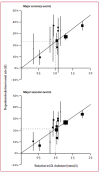The case for more intensive use of statins
- PMID: 23342235
- PMCID: PMC3539269
- DOI: 10.1177/2040622312454045
The case for more intensive use of statins
Conflict of interest statement
Figures



Similar articles
-
Association of statins with mortality in type 2 diabetes patients with intensive glycemic therapy.Diabetes Res Clin Pract. 2021 Sep;179:109005. doi: 10.1016/j.diabres.2021.109005. Epub 2021 Aug 12. Diabetes Res Clin Pract. 2021. PMID: 34391828
-
Diabetes mellitus and cardiovascular events in older patients with myocardial infarction prescribed intensive-dose and moderate-dose statins.Circ Cardiovasc Qual Outcomes. 2013 May 1;6(3):315-22. doi: 10.1161/CIRCOUTCOMES.111.000015. Epub 2013 May 14. Circ Cardiovasc Qual Outcomes. 2013. PMID: 23674307
-
Association Between Intensity of Low-Density Lipoprotein Cholesterol Reduction With Statin-Based Therapies and Secondary Stroke Prevention: A Meta-analysis of Randomized Clinical Trials.JAMA Neurol. 2022 Apr 1;79(4):349-358. doi: 10.1001/jamaneurol.2021.5578. JAMA Neurol. 2022. PMID: 35188949 Free PMC article.
-
Association of Lowering Low-Density Lipoprotein Cholesterol With Contemporary Lipid-Lowering Therapies and Risk of Diabetes Mellitus: A Systematic Review and Meta-Analysis.J Am Heart Assoc. 2019 Apr 2;8(7):e011581. doi: 10.1161/JAHA.118.011581. J Am Heart Assoc. 2019. PMID: 30898075 Free PMC article.
-
More- Versus Less-Intensive Lipid-Lowering Therapy.Circ Cardiovasc Qual Outcomes. 2019 Aug;12(8):e005460. doi: 10.1161/CIRCOUTCOMES.118.005460. Epub 2019 Aug 15. Circ Cardiovasc Qual Outcomes. 2019. PMID: 31412729
References
-
- Abraha I., Bonacini I., Montedori A., Abraha I., Bonacini I., Montedori A. (2006) Efficacy and safety of cholesterol-lowering treatment. Lancet 367: 469; author reply 470–471 - PubMed
-
- Alsheikh-Ali A., Ambrose M., Kuvin J., Karas R. (2005) The safety of rosuvastatin as used in common clinical practice: a postmarketing analysis. Circulation 111: 3051–3057 - PubMed
-
- Alsheikh-Ali A., Karas R. (2007) Safety of lovastatin/extended release niacin compared with lovastatin alone, atorvastatin alone, pravastatin alone, and simvastatin alone (from the United States Food and Drug Administration Adverse Event Reporting System). Am J Cardiol 99: 379–381 - PubMed
-
- Alsheikh-Ali A., Maddukuri P., Han H., Karas R., Alsheikh-Ali A., Maddukuri P., et al. (2007) Effect of the magnitude of lipid lowering on risk of elevated liver enzymes, rhabdomyolysis, and cancer: insights from large randomized statin trials. J Am Coll Cardiol 50: 409–418 - PubMed
-
- Alsheikh-Ali A., Trikalinos T., Kent D., Karas R., Alsheikh-Ali A., Trikalinos T., et al. (2008) Statins, low-density lipoprotein cholesterol, and risk of cancer. J Am Coll Cardiol 52: 1141–1147 - PubMed
LinkOut - more resources
Full Text Sources

